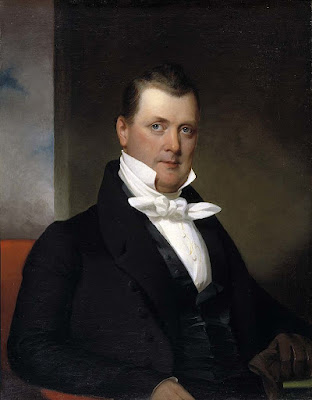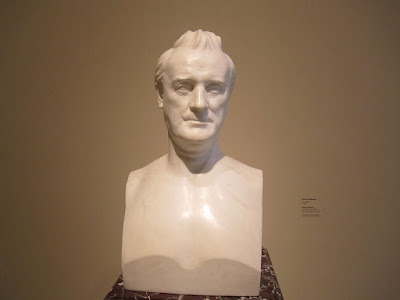When Abraham Lincoln was elected president in 1860, James Buchanan remained in office until March 4th of 1861. (The Twentieth Amendment, which later changed the regular inauguration date to January 20th, had not yet been passed.) Therefore, Southern states started seceding from the Union while James Buchanan was still in the White House. By the time that he left office, a full seven of them had seceded. But James Buchanan did nothing to stop them. The South was furious because Buchanan wouldn’t yield to their demands. And the North was also furious, because Buchanan wouldn’t stop Southern secession. Mr. Buchanan did practically nothing during this critical period. Thus, it would fall to his successor, Abraham Lincoln, to end the Southern attempts at secession. The seeds of the Civil War were being sown (at least in part) during James Buchanan’s administration. This is why Buchanan is typically ranked among the worst presidents in American history. But more about that aspect of the story later. For now, let me try to answer a relatively simple question: Where exactly did James Buchanan come from?
James Buchanan
Early life and career, through the presidential elections of 1856
James Buchanan Jr. was born in a log cabin in Pennsylvania in 1791. Thus, he was the last of our presidents to be born in the eighteenth century. The future president was the second of eleven children. James Buchanan eventually attended Dickinson College, but was nearly expelled for disorderly conduct. That is, he and his friends had gotten drunk, disturbing the peace at night and even committing acts of vandalism. But Buchanan pleaded for a second chance, and thus ultimately graduated with honors in 1809. That is, James Buchanan had a degree in the traditional Classics curriculum of the time. As was common in those days, he read for the law for two and a half years. Buchanan studied the United States Code and the United States Constitution, as well as legal authorities like Sir William Blackstone. In 1812, James Buchanan passed the bar exam, and finally became a lawyer. In 1814, Buchanan entered politics, and was elected to the Pennsylvania state House of Representatives. James Buchanan was then a member of the Federalist Party. In 1816, Buchanan took a break from politics, and returned to his law practice. But, in 1820, James Buchanan was elected to the federal House of Representatives. Crucially, Buchanan soon became a Democrat in 1824. In 1829, James Buchanan became the Chairman of the House Judiciary Committee. He again took a break from politics (this time, a short one) in 1831. In 1832, Andrew Jackson appointed James Buchanan as his Minister to Russia. Buchanan served in that capacity until 1833. In 1834, Buchanan was elected as a United States Senator. He served in the Senate for more than a decade. In 1845, James Buchanan then became the Secretary of State, serving under Presidents James K. Polk and Zachary Taylor. James Buchanan soon left that office in 1849. In 1853, Buchanan was then appointed as Franklin Pierce’s ambassador to the United Kingdom. Buchanan would serve in that capacity until 1856. Crucially, this meant that James Buchanan was abroad, when the national debate about slavery began to intensify the bitter divisions at home. By being abroad, Buchanan did not immediately have to take sides in that controversial debate. This allowed Buchanan to avoid the issue somewhat, when he returned to America in 1856. Since he had resigned from being an ambassador in March of 1856, he was a private citizen when he first became a serious contender for the presidency in that same year: 1856.
James Buchanan
Buchanan had run for president many times before, but this election was different
In 1856, the incumbent president was Franklin Pierce, Buchanan’s fellow Democrat. Again, Buchanan had served as Pierce’s ambassador to the United Kingdom. But Franklin Pierce’s pro-slavery policies were proving somewhat unpopular with Northern voters. In particular, Northerners disliked Pierce’s support for the pro-slavery faction in the ongoing fighting in Kansas. Thus, James Buchanan ran against Pierce for the Democratic nomination that year. I should note that Buchanan had run for president many times before, including in an early campaign back in 1844. But 1856 was the first time in which James Buchanan was actually securing his party’s nomination. This was also the first election in which the Whig political party failed to put forward a presidential candidate. The Whig political party was on its way out, and two other parties were competing to fill the void that the Whigs had left behind. One of these parties was a group called the “Know-Nothing Party.” (That’s really what it was called: the “Know-Nothing Party.”) In this election, their candidate was the former president Millard Fillmore. The “Know-Nothings” were opposed to immigration, particularly from Catholics. The “Know-Nothings” also presented themselves as the only party capable of bridging the sectional divides.
James Buchanan
The Republicans field their first candidate, but James Buchanan wins in 1856
But this was also the very first election in which the brand-new Republican Party was fielding a serious presidential candidate. Specifically, they put forward John C. Frémont, a Georgia-born man who was against slavery. But Frémont had been elected to various offices out west – including as United States Senator from California, and as Governor of the Arizona Territory. Thus, Frémont may have been more of a Westerner by that time than a true Southerner. Frémont had also served in the then-recent Mexican-American War. Frémont’s Republicans were campaigning to prevent slavery from spreading further west. The Republicans also wanted slavery to be removed from the District of Columbia. By contrast, Southern Democrats wanted slavery to move west. Northern Democrats, by contrast, wanted each state to decide the slavery question for itself. This doctrine, known as “popular sovereignty,” had produced the then-ongoing fighting in Kansas. Buchanan said that a Republican victory would lead to disunion. As Wikipedia puts it, “All three major parties found support in the North, but the Republicans had virtually no backing in the South.” (Source: Their page on the “1856 United States presidential election”) The “Know-Nothing” candidate, former president Millard Fillmore, won 21.5% of the popular vote in 1856, and 2.7% of the electoral vote. The Republican candidate John C. Frémont won 33.1% of the popular vote, and 38.5% of the electoral vote. And the Democratic candidate James Buchanan won 45.3% of the popular vote, and 58.8% of the electoral vote. Thus, James Buchanan had just been elected the 15th President of the United States.
James Buchanan
An overview of James Buchanan’s presidency, and its failure to stop secession
But, as Wikipedia puts it, James Buchanan soon intervened to “assure the Supreme Court's majority ruling in the pro-slavery decision in the Dred Scott case. He acceded to Southern attempts to engineer Kansas' entry into the Union as a slave state under the Lecompton Constitution, and angered not only Republicans but also Northern Democrats. Buchanan honored his pledge to serve only one term and supported Breckinridge's unsuccessful candidacy in the 1860 presidential election. He failed to reconcile the fractured Democratic Party amid the grudge against Stephen Douglas, leading to the election of Republican and former Congressman Abraham Lincoln.” (Source: Their page on “James Buchanan”) Time does not permit me to cover the crucial 1860 elections in detail here. But Wikipedia then continues by saying that “Buchanan's leadership during his lame duck period, before the American Civil War, has been widely criticized. He simultaneously angered the North by not stopping secession and the South by not yielding to their demands. He supported the Corwin Amendment in an effort to reconcile the country. He made an unsuccessful attempt to reinforce Fort Sumter, but otherwise refrained from preparing the military. In his personal life, Buchanan never married and was the only U. S. president to remain a lifelong bachelor … His failure to forestall the Civil War has been described as incompetence, and he spent his last years defending his reputation.” (Source: Their page on “James Buchanan”)
Bust of James Buchanan
Conclusion: Buchanan was one of the worst presidents in American history
Buchanan eventually died back in Pennsylvania in 1868, a few years after the Civil War had ended. He was 77 years old. Again, historians and scholars rank Buchanan as one of the worst presidents in American history. I tend to agree with this assessment. But he was followed by one of the best presidents (arguably the very best president), which was Abraham Lincoln. Abraham Lincoln’s administration would be rocked by the Civil War, which eventually claimed half a million American lives.
“Meanwhile the Administration of President Buchanan looked helplessly on and proclaimed that the general government had no power to interfere; that the Nation had no power to save its own life. Mr. Buchanan had in his cabinet two members at least, who were as earnest—to use a mild term—in the cause of secession as Mr. Davis or any Southern statesman. One of them, Floyd, the Secretary of War, scattered the army so that much of it could be captured when hostilities should commence, and distributed the cannon and small arms from Northern arsenals throughout the South so as to be on hand when treason wanted them. The navy was scattered in like manner. The President did not prevent his cabinet preparing for war upon their government, either by destroying its resources or storing them in the South until a de facto government was established with Jefferson Davis as its President … Treason in the executive branch of the government was estopped. But the harm had already been done. The stable door was locked after the horse had been stolen.”
– Ulysses S. Grant, in the “Personal Memoirs of Ulysses S. Grant” (published 1885), Volume I, Chapter XVI (incidentally, Grant had once voted for Buchanan, and regretted his choice)
If you liked this post, you might also like:
Part of a series about
The Presidents
1. George Washington
2. John Adams
3. Thomas Jefferson
4. James Madison
5. James Monroe
6. John Quincy Adams
7. Andrew Jackson
8. Martin Van Buren2. John Adams
3. Thomas Jefferson
4. James Madison
5. James Monroe
6. John Quincy Adams
7. Andrew Jackson
15. James Buchanan
17. Andrew Johnson27. William Howard Taft
31. Herbert Hoover
32. Franklin Delano Roosevelt
33. Harry S. Truman
34. Dwight D. Eisenhower
35. John F. Kennedy
36. Lyndon B. Johnson
37. Richard Nixon
38. Gerald Ford
39. Jimmy Carter
40. Ronald Reagan
41. George H. W. Bush
42. Bill Clinton
43. George W. Bush
44. Barack Obama
46. Joe Biden
32. Franklin Delano Roosevelt
33. Harry S. Truman
34. Dwight D. Eisenhower
35. John F. Kennedy
36. Lyndon B. Johnson
37. Richard Nixon
38. Gerald Ford
39. Jimmy Carter
40. Ronald Reagan
41. George H. W. Bush
42. Bill Clinton
43. George W. Bush
44. Barack Obama
46. Joe Biden








No comments:
Post a Comment